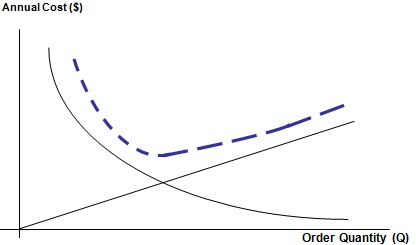Reference no: EM131299735
Inventory Management Practice Exercises
1. What is the re-order point (R/ROP) given an average daily demand of 50 units and a lead time of 10 days?
2. If annual demand is 12,000 units, the ordering cost is $6 per order and the holding cost is $2.50 per unit per year, what is the optimal order quantity using the Economic Order Quantity model?
3. Annual demand is 50,000 units, the ordering cost is $25 per order and the holding cost is $5 per unit per year.
a) What is the Annual Holding Cost function (formula)?
b) What is the Annual Ordering Cost function (formula)?
c) What is the Total Cost function (formula)?
4. An electronic company wishes to determine the best order size for its best selling data storage equipment. The company has estimated the annual demand of 1000 units. The holding (carrying cost) is 10% of selling price of $1000 and the ordering cost is $25 to place.
a) What are the annual holding cost, annual ordering cost and total cost functions for this company?
b) Determine the economic order quantity.
c) What is the average storage equipment on hand (average inventory)?
d) How many orders per year will there be?
e) What is the time between each order?
f) What is the minimum total annual cost?
g) Annual sales is expected to increase by 50% next year, how would the EOQ changes?
5. A particular raw material is available to a company at three different prices, depending on the size of the order:
Less than 100 pounds $20 per pound
100 pounds to 1000 pounds $19 per pound
More than 1000 pounds $18 per pound
The cost to place an order is $40. The annual demand is 3,000 pounds. Holding (or carrying) cost is $4.75 per pound. Should the company take advantage of the price break? What would be the order size?
6. The graph below shows the Economic Order Quantity model. On the graph, clearly identify:
Annual Holding Cost Function
Annual Ordering Cost Function
Total Cost Function
Optimal Order Quantity

|
How consumers make decisions whether or not to buy product
: pply the categorization model to a product category other than beverages.- How do consumers make decisions whether or not to buy the product, and how do they arrive at their final brand decision?
|
|
Define the elements of object oriented analysis
: 1. How to communicate effectively, both orally and in writing. 2. Describe the phases of the SDLC. 3. Define the elements of object oriented analysis. 4. Define and describe the activities of the systems analyst.
|
|
Evaluate the positioning of each brand
: Pick a category basically dominated by two main brands.- Evaluate the positioning of each brand. Who are their target markets?
|
|
Future global cyber security issues
: Discuss the ethics associated with Future Global Cyber Security Issues. Specifically discuss the ethical issues associated with the implementation of global cybersecurity policy and the interconnectedness of cyber security to society as it relate..
|
|
Inventory management practice exercises
: If annual demand is 12,000 units, the ordering cost is $6 per order and the holding cost is $2.50 per unit per year, what is the optimal order quantity using the Economic Order Quantity model?
|
|
What competitive frames of reference does it face
: Consider a book store in your area. What competitive frames of reference does it face? What are the implications of those frames of reference for its positioning?
|
|
How managing liquidity fits into your financial plan
: Role of Budgeting. How does budgeting fit into your financial plan? How is your financial plan affected by your spending? What is the budgeting trade-off?
|
|
Write a function called gimmeindex that returns the index
: Write a function called gimmeIndex() that returns the index of the largest value stored in an array-of-doubles. Demonstrate the function in a program that passes the name and size of the array to your function.
|
|
Any negatively correlated attributes and benefits
: Can you think of any negatively correlated attributes and benefits other than those listed? Can you think of any other strategies to deal with negatively correlated attributes and benefits?
|